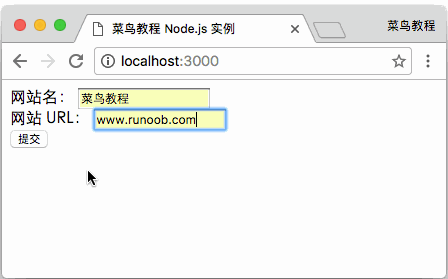Node.js GET/POST请求
在很多场景中,我们的服务器都需要跟用户的浏览器打交道,如表单提交。
表单提交到服务器一般都使用 GET/POST 请求。
本章节我们将为大家介绍 Node.js GET/POST请求。
获取GET请求内容
由于 GET 请求直接被嵌入在路径中,URL 是完整的请求路径,包括了 ? 后面的部分,因此你可以手动解析后面的内容作为 GET 请求的参数。
node.js 中 可以使用 URL 构造函数解析请求的 URL。
URL 对象是 Node.js 中用于解析和操作 URL 的一种标准工具。它提供了方便的接口来访问和修改 URL 的各个组成部分,如协议、主机名、路径、查询参数等。
实例
在浏览器中访问 http://localhost:3000/user?name=菜鸟教程&url=www.runoob.com 然后查看返回结果:

获取 URL 的参数
我们可以使用 url.parse 方法来解析 URL 中的参数,代码如下:
实例
在浏览器中访问 http://localhost:3000/user?name=菜鸟教程&url=www.runoob.com 然后查看返回结果:

URL 对象
以下是 URL 对象的属性和方法:
| 属性/方法 | 描述 | 示例输出 |
|---|---|---|
| href | 完整的 URL 字符串 | "http://example.com:8080/path?foo=bar#section" |
| origin | URL 的源,包括协议、主机名和端口号(如果存在) | "http://example.com:8080" |
| protocol | URL 的协议部分,后面带有 : | "http:" |
| host | 主机名和端口号 | "example.com:8080" |
| hostname | 主机名,不包含端口号 | "example.com" |
| port | 端口号(如果指定) | "8080" |
| pathname | 路径名部分 | "/path" |
| search | 查询字符串部分,包含开头的 ? | "?foo=bar&hello=world" |
| searchParams | URLSearchParams 对象,用于操作查询参数 | { foo: 'bar', hello: 'world' } |
| hash | 锚点部分,包含 # | "#section" |
| 方法 | 描述 | 示例代码 | 示例输出 |
|---|---|---|---|
| get(name) | 获取指定名称的查询参数值 | myUrl.searchParams.get("foo") | "bar" |
| append(name, value) | 向查询字符串中追加新的参数 | myUrl.searchParams.append("newKey", "newValue") | ?foo=bar&newKey=newValue |
| set(name, value) | 设置查询字符串中指定名称的参数(若已存在则更新) | myUrl.searchParams.set("foo", "newBar") | ?foo=newBar |
| delete(name) | 删除指定名称的查询参数 | myUrl.searchParams.delete("foo") | ?hello=world |
| has(name) | 判断查询字符串中是否存在指定名称的参数 | myUrl.searchParams.has("foo") | true 或 false |
| forEach(callback) | 遍历查询参数的键值对,并执行回调函数 | myUrl.searchParams.forEach((v, k) => console.log(k, v)) | 键值对输出 |
| toString() | 将查询参数转换为字符串形式,适合重新构建 URL | myUrl.searchParams.toString() | "foo=bar&hello=world" |
实例
console.log(myUrl.pathname); // 输出: /path
console.log(myUrl.searchParams.get("foo")); // 输出: bar
myUrl.searchParams.append("newKey", "newValue");
console.log(myUrl.href); // 输出: http://example.com/path?foo=bar&hello=world&newKey=newValue
获取 POST 请求内容
在 Node.js 中,处理 POST 请求通常需要通过 http 模块来接收请求体中的数据。POST 请求数据不像 GET 请求那样包含在 URL 中,而是作为请求体发送。因此,在 Node.js 中接收 POST 数据时,需要监听并处理 request 对象的 data 和 end 事件。
- 监听
data事件:当数据块到达服务器时,data事件触发,数据块作为回调的参数传递。 - 监听
end事件:当整个请求体接收完毕时,end事件触发,这时可以对完整的 POST 数据进行处理。
实例
// 创建 HTTP 服务器
http.createServer((req, res) => {
// 检查请求方法是否为 POST
if (req.method === 'POST') {
let body = '';
// 监听 data 事件,逐块接收数据
req.on('data', (chunk) => {
body += chunk; // 累加接收到的数据块
});
// 监听 end 事件,数据接收完毕
req.on('end', () => {
// 输出接收到的 POST 数据
console.log('Received POST data:', body);
// 设置响应头和内容
res.writeHead(200, { 'Content-Type': 'text/plain' });
res.end('POST data received successfully!');
});
} else {
// 非 POST 请求的处理
res.writeHead(405, { 'Content-Type': 'text/plain' });
res.end('Only POST requests are supported.');
}
}).listen(3000, () => {
console.log('Server is running at http://localhost:3000');
});
代码说明:
- 检测请求方法:通过
req.method === 'POST'来判断请求类型是否为 POST。 - 接收数据:在
req.on('data')事件中累加数据块,形成完整的数据体。 - 完成接收:在
req.on('end')事件中处理完整的 POST 数据。 - 响应客户端:完成数据接收和处理后,向客户端发送响应。
你可以使用 curl 命令来测试 POST 请求:
curl -X POST -d "name=example&age=25" http://localhost:3000
处理 JSON 数据
如果 POST 请求发送的是 JSON 数据,可以在 req.on('end') 中将接收的数据解析为对象:
req.on('end', () => {
const parsedData = JSON.parse(body); // 将 JSON 字符串解析为对象
console.log('Received JSON data:', parsedData);
res.end('JSON data received successfully!');
});
querystring 模块
querystring 模块用于处理 URL 查询字符串和 POST 请求的数据。
对于 application/x-www-form-urlencoded 编码的 POST 请求数据,querystring 模块可以帮助解析请求体,将它转换成 JavaScript 对象,方便访问和操作。
假设客户端发送的 POST 请求数据格式为 application/x-www-form-urlencoded(例如表单提交),数据形式类似于 name=example&age=25。在接收到数据后,可以使用 querystring.parse 方法将数据解析成对象。
基本语法结构说明
以下实例表单通过 POST 提交并输出数据:
实例
执行结果 Gif 演示:

